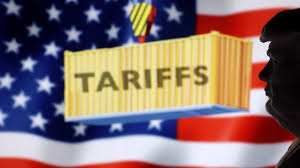What tariffs has Trump announced and why?
US President Donald Trump's sweeping global programme of tariffs is now in effect, meaning American buyers of many goods will have to pay more for their imports.
Since returning to office in January, Trump has introduced a series of these import taxes, and threatened many more.
The rates at which these taxes are charged vary widely. Goods from certain countries with which Trump has political grievances are subject to particularly high rates. Goods from other countries face lower rates if Trump has struck deals with them.
Trump argues that the tariffs boost American manufacturing and protect jobs.
However, his volatile international trade policy has thrown the world economy into chaos, and a number of firms have increased prices for US consumers as a result.
What are tariffs and how do they work?
Typically, they are a percentage of a product's value.
A 10% tariff means a $10 product has a $1 tax on top - taking the total cost to the importer of $11 (£8.35).
Companies that bring foreign goods into the US have to pay the tax to the government.
They may pass some or all of the extra cost on to customers. Firms may also decide to import fewer goods.
At the end of May, a US trade court ruled that Trump did not have the authority to impose some of the tariffs he has announced, because he did so under national emergency powers.
But the following day, an appeals court said the relevant taxes could stay in place while the case continued.
Why is Trump using tariffs?
Trump says tariffs will encourage US consumers to buy more American-made goods, increase the amount of tax raised and boost investment.
He wants to reduce the gap between the value of goods the US buys from other countries and those it sells to them - known as the trade deficit. He argues that America has been taken advantage of by "cheaters", and "pillaged" by foreigners.
The president has announced different tariffs against specific goods, and imports from individual countries.
Many of these have been subsequently amended, delayed or cancelled altogether.
Critics accuse Trump of making dramatic and sometimes contradictory policy statements as a negotiating tactic to encourage trade partners to agree deals that benefit the US.
Which tariffs has the US put in place on specific goods?
The taxes on goods imported to the US include:
- 50% tariff on steel and aluminium imports
- 50% tariff on copper imports from 1 August
- 25% tariff on foreign-made cars and imported engines and other car parts
On 8 July, Trump threatened to impose a 200% tariff on pharmaceutical imports but no further details have been confirmed.
Trump has also said the global tariff exemption covering goods valued at $800 or less will end on 29 August.
Which tariffs has the US put in place against individual countries?
A patchwork of different rates is now in effect.
Many of these stem from an announcement on 2 April, when Trump said a "baseline tariff" of 10% would apply to all other imports from all countries.
The US president said goods from about 60 other trade partners which the White House described as the "worst offenders" would face higher rates, as payback for unfair trade policies.
These "reciprocal" tariffs were later postponed for 90 days to allow time to negotiate individual trade deals. The deadline was then extended until 1 August and then to 7 August.
Tariff rates that are now in effect include:
- 50% tariffs on Brazilian goods
- 30% tariffs on South African goods
- 20% tariffs on Vietnamese goods
- 19% tariffs on Indonesian goods
- 19% tariffs on Filipino goods
- 15% tariffs on Japanese goods
- 15% tariffs on South Korean goods
The rate that will be charged on Indian goods is set to climb to 50% on 27 August, as a consequence of Delhi's purchases of Russian oil.
What are the economic effects of import tariffs?
A less productive economy requires fewer workers," Silvia said in an analysis note. "But there is more, the higher tariff prices lower workers' real wages. The economy has become less productive, and firms cannot pay the same real wages as before. Actions have consequences.
